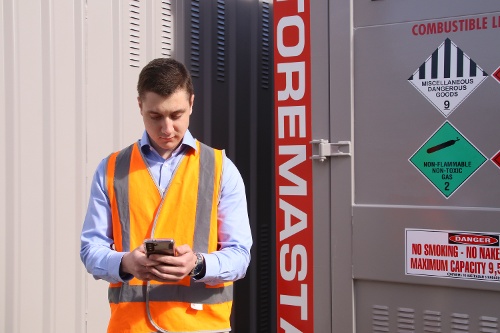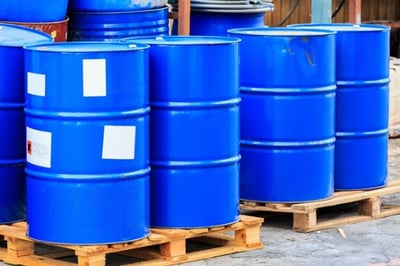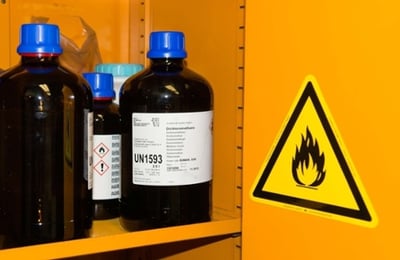Here at STOREMASTA, we’re serious about safe chemical storage. But with 9 dangerous goods classes and a wide range of hazards, it’s not always a simple process to determine your hazardous chemical storage needs. So, to make things a bit simpler for you, we’ve created 5 steps to storing chemicals safely, so your workplace can comply with WHS laws and Australian Standards.
Applying the risk management methodology
When managing the risks associated with hazardous chemicals and dangerous goods in the workplace, it is very important that you follow the STOREMASTA methodology. This methodology has four phases, and all phases must be applied to ensure that your workplace is protected from the risk associated with hazardous chemicals.
The 4 phases of this methodology are
- Identify
- Assess
- Control
- Sustain
If you don’t apply this methodology, the chemical storage solution that you implement may not be the correct solution to mitigate the risk associated with the hazardous substances stored onsite.

By identifying, assessing and controlling your chemical risks, you’ll be able to create a safer working environment.
STEP 1. Identify the substances you are using
The first step in storing hazardous chemicals safely is to correctly identify each substance you have onsite. This step is crucial as identifying the chemicals you’re carrying will provide you with the knowledge to understand their properties and hazards.
For example, you’ll be able to answer queries such as:
- Is the chemical flammable, toxic or corrosive?
- Is it self-reactive or does it react to sunlight?
- Is it incompatible with other substances?
- Can it negatively affect the environment or aquatic life?
To find out the properties associated with the hazardous chemicals that you’re storing, you’ll need the safety data sheet (SDS). The SDS for each substance you carry can be provided by the chemical manufacturer, importer or supplier.
You must keep up to date copies of each SDS close to your stores, preferably in a document holder attached to your stores. It’s important that the staff tasked with this job read the SDS thoroughly so they can clearly and accurately identify all properties and hazards that will affect the storage of workplace chemicals.
REMEMBER: The safety data sheet will specify the storage requirements for the hazardous chemicals, as well as any incompatible substances or environmental conditions that might cause an adverse reaction like a fire or explosion.
STEP 2. Assess the risks associated with the chemicals
Once you have identified the chemical and understand why it’s dangerous, you are ready to look more closely at each of the risks associated with its use.
Risks will include hazards for human health, damage to property and pollution of the natural environment.

The first step to store chemicals safely is to determine their properties and hazards by reviewing the SDS.
When assessing your onsite chemicals, you might consider risks such as:
- fire and explosion
- gas leak with workers being asphyxiated
- corrosives reacting with metal and damaging buildings or plant
- acute toxic liquids spilling and contacting workers
- workers developing cancer from long term exposure to carcinogens
To streamline the process of determining specific risks, we suggest you create a master list of hazardous chemicals. This master list should specify each of the chemicals you use onsite. You can then collate all the safety data sheets and work your way through the list, noting every risk and every hazard associated with every single chemical.
REMEMBER: If your onsite team don’t have the knowledge or experience to conduct an assessment such as this, make sure you contact an industry expert to assist with the process, such as a Dangerous Goods Consultant.
If you’re carrying petrol at your site, your list of hazards and risks may look something like this:
|
Chemical |
Hazard |
Risks and concerns |
|
Petrol |
Flammable |
Petroleum storage tanks located near perimeter fence. Delivery drivers waiting to access site smoking in their vehicles outside the fence (but directly adjacent to the petrol storage tanks). Could cause a fire or explosion. |
|
Irritating to skin |
Workers decanting petrol into portable containers spilling fuel at storage area. Workers decanting the fuel are getting petrol on their skin. |
|
|
Vapours may cause drowsiness and dizziness. May cause cancer |
Workers decanting petrol into portable containers spilling fuel at storage area. Fumes are spreading to work areas and manufacturing staff are breathing petrol vapours. |
STEP 3. Systematically control each of the risks
Now it’s time to control each of the risks of your hazardous chemicals.
To control risks and hazards in the workplace, WHS Managers and Professionals use a system known as the Hierarchy of Control. As an international standard for risk control, you can apply the Hierarchy of Control in your own workplace.
There are 5 control measures to consider when using the Hierarchy of Control and each should be performed in the following order:
- Elimination (could you stop using the chemical?)
- Substitution (could you use a different chemical that is less harmful?)
- Engineering controls (could you design the workplace to reduce the amount of employees who are exposed to the chemical?)
- Administrative controls (can you implement safe work methods?)
- Personal protective equipment (what protective equipment could be used to protect workers?)
Let’s now use the Hierarchy of Control in our petrol example from section 2 (above).
|
Hazard |
Risk and Concerns |
Control Measure |
|
Flammable |
Petroleum storage tanks located near perimeter fence. Delivery drivers waiting to access site smoking in their vehicles outside the fence but directly adjacent to the petrol storage tanks. Could cause a fire or explosion. |
1. Elimination Remove the petrol storage drums from site and have staff fill company vehicles offsite. 2. Substitution Use biodiesel instead of petrol. 3. Engineering controls Move the petroleum tanks away from the perimeter of the fence and store it in a compliant flammable cabinet. 4. Administrative controls Place NO SMOKING signage outside the fence and have a standard procedure that prohibits smoking within 100 metres of the site perimeter. 5. PPE Have all the staff and personnel wear full coverage fire resistant suits whenever they approach the petroleum storage area. |
REMEMBER: The goal in risk control is to completely eliminate the risk, if possible. You must never use PPE as the lone control method as it is regarded the least effective means of chemical risk control. PPE, while essential in the workplace, should only be used as a risk control after every other step in the process has been completed.
STEP 4. Store the hazardous chemicals correctly
You know all about the substances, you know how they can cause harm, and you know the specific risks of storing them at your worksite. Armed with this information, you will be able to take proactive measures to ensure that the hazardous substances are stored in a safe and compliant manner.
When deciding on the best method of storage you should begin with the chemical’s hazard class (ie, flammable, gas under pressure, oxidiser, explosive) and the specifications outlined on the SDS.
The SDS will quickly tell you whether the hazardous chemical should be stored indoors or outdoors, whether it needs to be separated from other substances (or even light), and how much ventilation it needs.
How Should Flammable and Hazardous Substances Be Stored?
One of the most volatile and commonly used dangerous goods classes, flammable liquids require strict chemical storage procedures if workplaces are to reduce the risk of fire, explosion, flashback and human harm. Flammable vapours and chemical spills can quickly turn into dangerous situations which may impact people and property – as well as the surrounding community and environment.
Flammable and hazardous substances require a range of controls including the containment of spills, the control of flammable vapours and protection from impact damage or theft. Due to the range of hazards associated with these chemicals, they must be stored in compliant stores that meet all the requirements of the Australian Standard AS 1940.
Not only must the design and construction of the storage facility meet these requirements, but there must be procedures and training put in place to ensure that no hazards are brought into the storage areas. These include the exclusion of ignition sources and the segregation of incompatible substances.
Separate flammable chemicals from ignition sources
If you identify that a number of your hazardous substances are classified as flammable liquids, solids or gases, you will have to separate these substances from ignition sources. If flammable gases, liquids or solids come into contact with an ignition source, it will result in a fire that could harm people and property. To reduce the risk of fires, all flammable chemicals must be stored in compliant flammable cabinets and separated from ignition sources by a distance of at least 3 metres.
Storage in Safety Cabinets
For many chemicals, a lockable safety cabinet specifically designed for the chemical’s hazard class is an essential control measure.

Safe storage options include indoor safety cabinets.
Here are some examples of suitable safety cabinets:
- Explosives and detonators: this class should be stored in an explosive storage cabinet with timber lining constructed from fully welded 2mm steel. They must feature heavy duty internal locking system and hinges for safety and security.
- Corrosives: there are 2 types of corrosive storage cabinets: metal and high-density polyethylene. Highly corrosive substances that emit sufficient corrosive vapours must be stored in a poly cabinet to prevent corrosion of the store. Less corrosive substances may be safely stored in a compliant metal cabinet.
- Flammable liquids: A compliant flammable cabinet features perforated shelving to allow free movement of flammable vapours. The high-capacity liquid tight sump is designed to contain any spills.
Gas cylinder racks and cages
Gas cylinders should be stored in compliant racks and cages made from heavy-duty steel and mesh walls. This construction provides ample natural ventilation for storing aerosols, gas cylinders and bottles safely.
We recommend that your gas cylinder racks and cages are located outdoors and permanently secured using bolt down plates.
Other storage considerations
There are many other considerations you must make to ensure that your chemicals are stored safely. These include:
Storing chemicals outdoors: Outside storage areas benefit from natural ventilation and reduced human exposure to gas leaks and chemical spills. You should choose an area with minimal traffic, so there is less chance of impact damage or accidents occuring in the area. A chemical storage container that has been manufactured in full conformance to the Australian Standards is an excellent outdoor storage option.
Storing chemicals indoors: If chemicals react to heat and sunlight, outdoor storage is often not possible. You might store chemicals indoors if your outdoor areas are exposed to a lot of traffic, or operations involving heavy outdoor plant and machinery. And in some cases, there just is no outdoor areas available.
When storing chemicals indoors, a compliant chemical cabinet – suitable for the dangerous goods class of your substance – is a cost-effective and convenient option. These cabinets are equipped with the required engineering controls, such as spill containment bunds that meet the capacity requirements of the Australian Standards.
Like to know more about spill bunding?
Incompatible substances: When incompatible substances are mixed or come into contact with each other, they can cause violent chemical reactions and explosions. Storing chemicals within their hazard class eliminates a lot of problems associated with leaks and breakages in the storage area. How far you separate incompatible substances will depend on the degree of risk.
Chemical safety documents: To assist with the correct handling and storage of your chemicals, it’s imperative that all staff and contractors are aware of the hazards associated with each chemical. In your storage areas, make sure that you:
Keep a register of hazardous chemicals: A register of hazardous chemicals is a list of the product names of all the hazardous chemicals used, handled and stored onsite. The register must also have a copy of the safety data sheets for all the hazardous substances used in the workplace. This register must be updated as new chemicals are brought into the workplace and as the use of old hazardous chemicals are discontinued. All employees that are involved with the storage, handling and management of hazardous chemicals must have access to this register of hazardous chemicals.
Safety data sheets: it’s also important to keep an updated copy of the safety data sheets of each hazardous substance close to the area where they are stored. We recommend storing safety data sheets in a document storage box that is mounted on the side of the safety cabinet.
REMEMBER: Once all your hazardous chemicals are stored, you should conduct another risk assessment and review all your control measures to make sure no new hazards have been introduced to the workplace.
STEP 5. Setup a system to sustain compliance
Workplaces are in a constant state of change: new hazardous chemicals are introduced to the worksite, work areas are relocated, operating procedures change.
Reviewing your safety control measures is essential as you want to sustain a safe workplace and compliance to the WHS regulations.
Remember the petrol hazard at the workplace in the examples above? Let’s imagine that when we review our control measures, we discover that our administrative control has been ineffective in controlling the risks associated with this hazardous chemical.
| Hazard, Risks and Concerns | Control Measures | Review |
|
Flammable Petroleum storage tanks located near perimeter fence. Delivery drivers waiting to access site smoking in their vehicles outside the fence but directly adjacent to the petrol storage tanks. Could cause a fire or explosion. |
1. Elimination Remove the petrol storage drums from site and have staff fill company vehicles offsite. 2. SubstitutionUse biodiesel instead of petrol. 3. Engineering controlsMove the petroleum tanks away from the perimeter fence. 4. Administrative controlsPlace NO SMOKING signage outside the fence prohibiting smoking within 100 metres of the site perimeter. 5. PPEHave all the staff and personnel wear full coverage fire resistant suits whenever they approach the petroleum storage area. |
We decided to implement administrative controls to reduce the risk (after all that seemed like the cheapest option). But 30 days after erecting NO SMOKING signage outside the fence, delivery drivers are still parked outside near the petrol tanks and smoking in their vehicles. |
Your review process is an integral step of your risk control process, as it allows you to ensure that any new hazards are noted and actioned. Once you have adjusted your control measures and conducted a further risk assessment, you can then be sure that your hazardous chemicals have been stored safely.
However, this 5-step process is an ongoing one – and doesn’t end once you’ve controlled your chemical hazards. Keep in mind that you will have to regularly assess and review your chemical controls to maintain a safe workplace and effective chemical storage solutions.
Storage of chemicals in the workplace
Would you like to know more about the safe storage of chemicals in the workplace? Our eBook walks you through the risk management process — and offers an action plan and templates so you can easily implement a Chemical Management Plan at your workplace. Get your copy today and take the next step in safe chemical storage.
Joining the team as a Dangerous Goods Storage Consultant, Melissa Hampton became Storemasta's Marketing Manager in late 2021. With extensive knowledge and experience in chemical compliance, Melissa is responsible for leading the Marketing team and helping shape their marketing strategy. In her spare time, you can find Melissa hiking, swimming and enjoying the great outdoors in beautiful north-west Tasmania.
